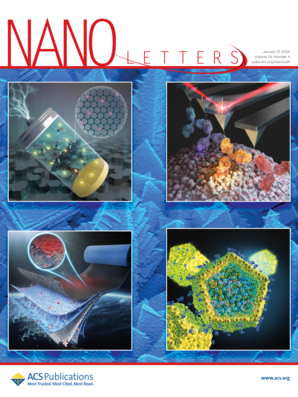Role of Conjugated Structure of Cross-linkers in Patterned QLEDs
IF 9.6
1区 材料科学
Q1 CHEMISTRY, MULTIDISCIPLINARY
引用次数: 0
Abstract
Direct optical lithography is a promising method for the high-resolution patterning of colloidal quantum dots (CQDs) in optoelectronic devices. However, this approach requires photo-cross-linkers that ensure strong chemical binding without degrading CQD ligands, while also supporting efficient charge transport. In this study, we compare two cross-linkers, 4,4′-thiobisbenzenethiol (TBBT) and biphenyl-4,4′-dithiol (BPDT), to evaluate their impact on CQD optoelectronic performance. Density functional theory (DFT) calculations reveal that the biphenyl structure of BPDT enables greater π-orbital overlap and a narrower bandgap than TBBT, which contains sulfur-conjugated units. As a result, BPDT enhances charge injection, preserves photoluminescence, and improves the external quantum efficiency of patterned CQD light-emitting diodes. These findings provide molecular-level insight into cross-linker design strategies for efficient, high-resolution patterning of CQD-based optoelectronics.

交联剂共轭结构在图案qled中的作用
直接光学光刻是光电子器件中胶体量子点(CQDs)高分辨率图像化的一种很有前途的方法。然而,这种方法需要光交联剂,以确保强化学结合而不降解CQD配体,同时还支持有效的电荷传输。在这项研究中,我们比较了两种交联剂,4,4 ' -硫代双硫醇(TBBT)和联苯-4,4 ' -二硫醇(BPDT),以评估它们对CQD光电性能的影响。密度泛函理论(DFT)计算表明,BPDT的联苯结构比含硫共轭单元的TBBT具有更大的π-轨道重叠和更窄的带隙。结果表明,BPDT增强了电荷注入,保持了光致发光,提高了图像化CQD发光二极管的外量子效率。这些发现为基于cqd的光电子学的高效、高分辨率模式的交联设计策略提供了分子水平的见解。
本文章由计算机程序翻译,如有差异,请以英文原文为准。
求助全文
约1分钟内获得全文
求助全文
来源期刊

Nano Letters
工程技术-材料科学:综合
CiteScore
16.80
自引率
2.80%
发文量
1182
审稿时长
1.4 months
期刊介绍:
Nano Letters serves as a dynamic platform for promptly disseminating original results in fundamental, applied, and emerging research across all facets of nanoscience and nanotechnology. A pivotal criterion for inclusion within Nano Letters is the convergence of at least two different areas or disciplines, ensuring a rich interdisciplinary scope. The journal is dedicated to fostering exploration in diverse areas, including:
- Experimental and theoretical findings on physical, chemical, and biological phenomena at the nanoscale
- Synthesis, characterization, and processing of organic, inorganic, polymer, and hybrid nanomaterials through physical, chemical, and biological methodologies
- Modeling and simulation of synthetic, assembly, and interaction processes
- Realization of integrated nanostructures and nano-engineered devices exhibiting advanced performance
- Applications of nanoscale materials in living and environmental systems
Nano Letters is committed to advancing and showcasing groundbreaking research that intersects various domains, fostering innovation and collaboration in the ever-evolving field of nanoscience and nanotechnology.
 求助内容:
求助内容: 应助结果提醒方式:
应助结果提醒方式:


